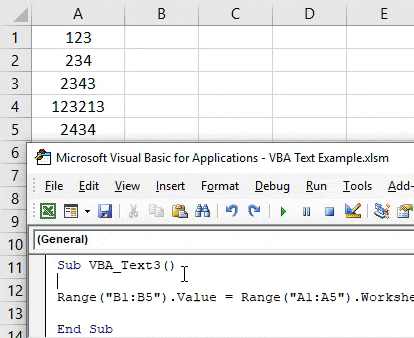

The following code sets the font size of cell A1 to 14. The value of this property can be set to an integer value from 1 to 409. Range("A1:A5").Font.FontStyle = "Italic" Font Size The following code sets the font style of range A1:A5 to Italic. The value of this property can be set to one of the constants: Regular, Bold, Italic, Bold Italic. Range("A1:A5").Font.Name = "Calibri" Font Style The following code sets the font name of range A1:A5 to Calibri. The value of this property can be set to one of the fonts: Calibri, Times new Roman, Arial. Range("A1").Orientation = xlHorizontal Font Font Name The following code example sets the orientation of cell A1 to xlHorizontal. The value of this property can be set to an integer value from –90 to 90 degrees or to one of the following constants: xlDownward, xlHorizontal, xlUpward, xlVertical. Range("A1").ReadingOrder = xlRTL Orientation The following code example sets the reading order of cell A1 to xlRTL (right-to-left). The value of this property can be set to one of the constants: xlRTL (right-to-left), xlLTR (left-to-right), or xlContext (context). Range("A1:A4").MergeCells = True Right-to-left Text direction This example merge range A1:A4 to a large one. This example causes text in row one to automatically shrink to fit in the available column width. Range("A1").WrapText = True Shrink To Fit This example formats cell A1 so that the text wraps within the cell. Range("A1").VerticalAlignment = xlBottom Text Control Wrap Text The following code sets the vertical alignment of cell A1 to bottom. The value of this property can be set to one of the constants: xlBottom, xlCenter, xlDistributed, xlJustify, xlTop. Range("A1").HorizontalAlignment = xlCenter Vertical The following code sets the horizontal alignment of cell A1 to center. The value of this property can be set to one of the constants: xlGeneral, xlCenter, xlDistributed, xlJustify, xlLeft, xlRight. When you close the Visual Basic Editor window, the regular Excel window will not close.Formatting Cells Number General Range("A1").NumberFormat = "General" Number Range("A1").NumberFormat = "0.00" Currency Range("A1").NumberFormat = "$#,#0.00" Accounting Range("A1").NumberFormat = "_($* #,#0.00_) _($* (#,#0.00) _($* Date Range("A1").NumberFormat = Time Range("A1").NumberFormat = "h:mm:ss Percentage Range("A1").NumberFormat = "0.00%" Fraction Range("A1").NumberFormat = "# ?/?" Scientific Range("A1").NumberFormat = "0.00E+00" Text Range("A1").NumberFormat = Special Range("A1").NumberFormat = "00000" Custom Range("A1").NumberFormat = "$#,#0.00_) ($#,#0.00)" Formatting Cells Alignment Text Alignment Horizontal

Locate your Excel file it will be called VBAProject (YOUR FILE'S NAME HERE) and click this. On the new window that opens up, go to the left side where the vertical pane is located.Then go to the Developer tab on the ribbon menu and on the far left Click Visual Basic Go to Office Button > Excel Options > Popular > Click Show Developer tab in the Ribbon.

Go to Tools > Macros > Visual Basic Editor Or For other ways to get there, Click Here. Press " Alt + F11" - This will open the Visual Basic Editor - Works for all Excel Versions.Open the Microsoft Excel file in which you would like the Macro to function.Select and copy the text from within the grey box above.


 0 kommentar(er)
0 kommentar(er)
